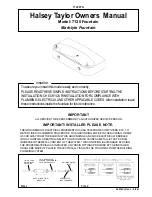
Page | 19
www.outdoorrooms.com
BCH-1242 42477 REV A
D. Normal Operating
Characteristics
DECORATIVE HEAT EXCHANGER TUBES
:
The tubes are made from stainless steel and can
withstand the heat generated by the burner.
The high-temperature coating on the tubes
requires an initial burn-off period of 4 hours to
get rid of residue from the coating process.
While the tubes are being heated, the other
components of the burner are being heated as
well. This can cause different rates of expansion.
This expansion can cause some metallic noises.
This is normal and not a cause for concern
.
Over time, the high-temperature coating will
change color due to the presence of carbon in the
flame/combustion gases.
This color change is due
to a normal physical process and does not mean
the coating is failing.
A reddish-brown tint and
dulling of color on the matte black tubes is
normal, it is not rust (
Image 6.10
).
Some soot build-up on the tubes is normal and
more soot build-up will occur with the use of LP
than with natural gas. Soot build-up can be
removed with a damp cloth (
Image 6.11
).
ONLY
USE WATER TO CLEAN HEAT EXCHANGER TUBES.
BURNER AND FLAME BEHAVIOR
:
The flame is susceptible to large air movement (gusts) and drafting. This causes movement of the flame
which will result in uneven heating of the heat exchanger tubes which then results in a marginal difference
between the heat outputs of the two vents.
Use of the optional glass guard will minimize these effects but
will not eliminate them.
This appliance is setup from the factory to have a cleaner burning, more blue flame. This helps to reduce the
potential for soot buildup as well as increases the effectiveness of the heat exchanger tubes. This leads to
more heat delivered through the optional heating vents.
EXAMPLE OF DULLING OF
HEAT EXCHANGER TUBE
FINISH
EXAMPLE OF COLOR
CHANGE OF HEAT
EXCHANGER TUBE
EXAMPLE OF POTENTIAL
SOOT BUILDUP ON HEAT
EXCHANGER TUBE
6.10
6.11
1








































